About Periodontal Disease
Our Approach
First of all, it is important for patients to understand the current situation themselves.
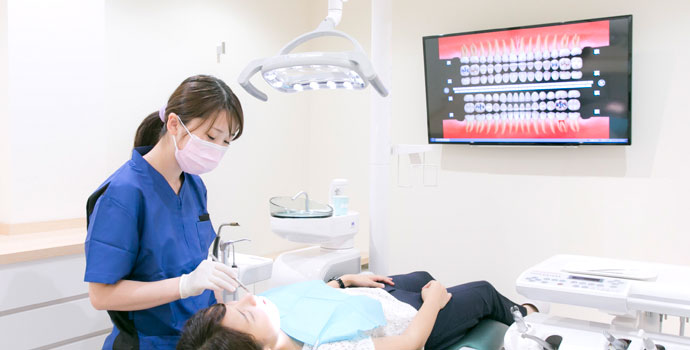
Periodontal disease is a general disease that occurs in the tissues surrounding the teeth. Gingivitis is when the inflammation is limited to the gums, and periodontitis is when gingivitis progresses to the periodontal tissues such as periodontal pockets and alveolar bone. Including gingivitis, which is also common among young people, it is reported that four out of five Japanese people have periodontal disease, making it the most common infectious disease and lifestyle-related disease.
Since the patient is unaware of the disease, the disease becomes serious when it is noticed.
Like tooth decay, periodontal disease is caused by periodontal infection, which in turn is caused by a combination of various factors such as lifestyle and body constitution. However, while many people are concerned about cavities because they become painful and visually obvious, many people are unaware of periodontal disease because there are almost no subjective symptoms in the early stages of the disease. When teeth begin to wobble, it is not uncommon for two-thirds of the alveolar bone to have already dissolved and the disease is severe.
Characteristics of our clinic
We start by determining the causes and risks of periodontal disease.
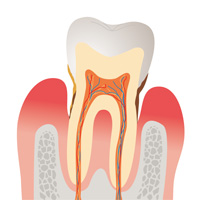
Periodontal disease is caused by periodontal bacteria. The surface of the teeth is covered with a thin, sticky film (plaque) made up of invisible bacteria.
The plaque contains a myriad of periodontal bacteria, and the toxins produced by these bacteria play a major role in the development and progression of periodontal disease. When the plaque calcifies, it turns into tartar, which adheres firmly to the tooth surfaces. As the plaque becomes tartar, more bacteria can enter in and around it and continue to emit toxins.
What are the risks of worsening gum disease?
It has been shown that diabetes increases the susceptibility to bacterial infection, which also makes gum disease more likely to progress. Conversely, periodontal treatment has been shown to improve blood sugar levels. Those diagnosed with diabetes should also be aware of periodontal disease.
In addition, clenching and grinding of the teeth during sleep can put undue stress on periodontal tissues and accelerate the progression of periodontal disease. If your parents or siblings lost teeth early in life, you may be more susceptible to periodontal disease. Also, if you are in your teens or twenties and frequently have swollen gums, you are probably infected with a special type of gum disease bacteria and should be careful.
Tobacco smokers should be especially careful.
Smoking cigarettes reduces blood circulation and nutritional supply, which in turn reduces cellular immunity, making it easier to contract periodontal disease, and the disease progresses more rapidly. In addition, the longer a smoker smokes, the more the gums change color from natural pink to black, and inflammation tends to be noticed later. It is important for smokers to undergo regular checkups and maintenance even if they do not have cavities. And we recommend that you quit smoking for the sake of your teeth and oral health.
Features of our clinic
We achieve plaque control through highly accurate and thorough treatment and prevention.
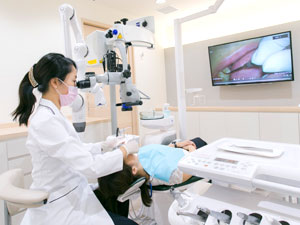
We first examine the periodontal pockets in detail with a microscope. We also check the condition of the alveolar bone using x-rays and carefully check for tooth movement. The overall balance of the teeth, including the bite, and gums are examined, and if necessary, a bacterial test for periodontal disease is performed before a diagnosis is made.
Periodontal disease is both an infectious disease and a lifestyle-related disease, so it is not enough to treat only the part that has deteriorated. Our clinic provides comprehensive treatment that assesses the causes and risks, considers lifestyle habits, and looks at overall oral health, as well as thorough tooth brushing instruction to prevent recurrence of the disease.
Teamwork with Dental Hygienists to Prevent Periodontal Disease
Dental hygienists also play an important role in the treatment of periodontal disease. Our clinic has introduced the assigned hygienist system, whereby the assigned dental hygienist is responsible for the patient’s care. First, the dental hygienist thoroughly removes tartar using a magnifying glass that allows better vision than the naked eye, and then the dentist removes the tartar using a microscope. Surgical treatment may be applied if necessary.
After treatment, our dental hygienists will provide detailed tooth brushing instruction, taking into consideration each patient’s individual tartar buildup, brushing technique, and lifestyle. If you have any questions or concerns, please feel free to contact us as often as you like.
Treatment of Early Periodontal Disease

Treatment of Early Periodontal DiseaseThe main actor in the treatment of early periodontal disease is the patient himself/herself, as it can be improved by continuing treatment to keep the teeth and the area around the teeth clean. We provide careful and easy-to-understand brushing instructions so that you can take good care of your teeth at home.
Brushing instruction to brush teeth well
It is difficult to check by yourself whether all of your teeth are well brushed. After understanding your teeth alignment and brushing habits, you will learn how to brush so that you can control plaque by yourself.
Scaling (removal of tartar)
Ultrasonic waves are used to remove tartar that is firmly adhered to the tooth surfaces. Tartar in periodontal pockets (grooves between the teeth and gums) is also carefully removed.
Root planing
If the periodontal pocket is 3 to 5 mm deep, the gums are anesthetized and then the tartar and plaque in the periodontal pocket are removed.
Treatment of moderate to severe periodontal disease
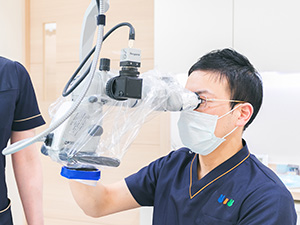
When inflammation has progressed deep into the gums and destruction of periodontal tissue is severe, periodontal surgery such as flap operation is performed. In more severe cases, periodontal tissue regeneration therapy such as Emdogain is used to restore periodontal tissue.
Flap Operation (Adhesive Therapy)
Scaling alone cannot remove tartar in areas with significant alveolar bone destruction and deep periodontal pockets. The gums are removed from the bone through an incision, and the tartar and infected gums are removed.
Periodontal tissue regeneration therapy (Emdogain)
This is a treatment method that promotes the regeneration of periodontal tissue by applying a type of protein.
Do you have any of these symptoms? Symptoms of periodontal disease
- Bad breath
- Sometimes blood comes out when you brush your teeth.
- Pus-like discharge from gums
- Cold drinks sting
- Gums are drooping
- Gaps between my teeth seem to be getting wider
- Teeth feel wobbly
- Gums may swell or hurt
Regenerative treatment
We are actively involved in tooth grafting and gingival regeneration therapy
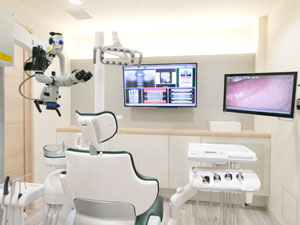
Regenerative therapy has been attracting attention in the areas of periodontal disease treatment and defective prosthodontics. Currently, this is an area of dentistry where research is progressing remarkably, so our clinic will pay attention to the results of domestic and international research and actively incorporate effective, up-to-date treatments.
What is gum grafting?
When some gums have receded for some reason, a gum graft can restore the condition of the receding gums. Resistant gums from the upper jaw are transferred to the area lacking strong gums to restore periodontal tissue.
Connective tissue grafting surgery for severe root surface exposure
Periodontal disease can cause the gums to recede, exposing the root surface (root surface exposure). Not only is this unsightly, but it can lead to sensitivity and tooth decay, and the stability of the tooth itself may deteriorate, making it difficult to chew hard foods. Our clinic also offers connective tissue grafting surgery as a treatment for root surface exposure.
We recommend regular checkups and PMTC because exposed root surfaces are difficult to care for by tooth brushing, etc. During PMTC, we clean the exposed root surfaces without damaging them, and carefully instruct you on how to brush your teeth and choose an appropriate toothbrush.
Frequently Asked Questions
歯周病はどんな病気ですか?
歯周病とは「歯を支える骨が溶ける病気」です。歯と歯ぐきの境目についた歯垢(プラーク)から歯の根に沿って菌が入り込み、歯を支えている周りの骨をじわじわと溶かしていき、最後には歯が抜け落ちてしまいます。
歯肉に炎症が起きた状態を歯肉炎、歯槽骨などを支えている組織全体が崩れてしまう病気を歯周炎と言います。
また、歯周病は「沈黙の病」などと呼ばれるようにほとんど自覚症状がないため、気づかない間に悪化させてしまうことがよくあります。
歯槽膿漏と歯周病は違うものですか?
同じものです。これまで、歯の周辺の歯肉が腫れ、膿が出るという症状から「歯槽膿漏」という名称が主に使用されていました。一方で最近は、歯肉だけでなく歯を支える歯槽骨をはじめ、歯の周辺の広範囲にさまざまな症状が表れるため「歯周病」という名称が多く用いられるようになりました。
歯周炎と歯肉炎は違うものですか?
歯周炎は、炎症が歯の周辺の広範囲に及んで、歯肉だけでなく歯を支える歯槽骨まで広がります。その症状には個人差があり、大半の歯槽骨を失うほどの重いケースもあります。
一方歯肉炎は、炎症が歯肉のみに及んでいる症状で、歯の周辺の歯槽骨は正常な状態にあります。
歯周病は何歳ぐらいから起こるものですか?
歯周病は成人してから起こるものと思われていますが、実は歯周炎の前段階とも言える歯肉炎は幼少期から起こりうるものなのです。
また歯周炎は、痛みなどの自覚症状がほとんどないために発見が手遅れになることもしばしばです。歯周病を予防するためには、毎日の歯磨きと歯科医院での定期検診が重要です。
歯周病はどのように予防するのでしょうか?
歯周病を予防するためには、何よりもまずプラークコントロールが不可欠です。歯の周辺に付着したプラーク(歯垢)を除去し、細菌を減らすことで歯周病の進行を食い止めることができます。
歯の上側の歯垢はご自身の毎日の歯磨きによって取り除くことができますが、歯肉の内側深く入り込んだ歯垢はご自身で除去できないため、歯科医院で清掃を行う必要があります。ご自身と歯科医院の相互の取り組みによって、歯周病を予防していきます。
歯周病はどうやって治すのでしょうか?
歯周病が進行し、溶けてしまった骨は戻すことができません。とにかく症状を悪化させないようにすることが大事です。
歯周病の原因は歯垢です。歯周病になってしまった際には、根源である歯垢=細菌をいかに減らしていくかが重要なポイントです。まずは、ご自身の毎日の歯磨きによって今以上に細菌を増加させないことが大切です。
